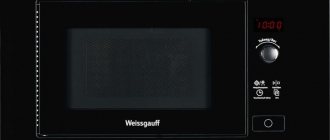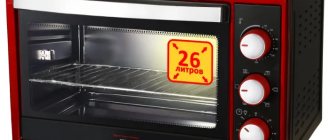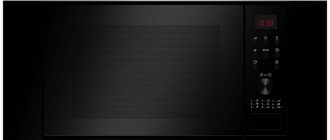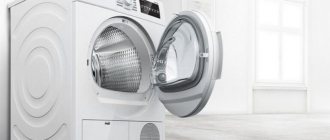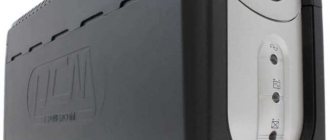Built-in microwave ovens
This is a functional and aesthetic option that is installed in kitchen furniture, creating a single composition. It’s nice that such equipment can replace an oven, if it has the necessary functions.
Control options for built-in microwave ovens:
- Push-button – control is carried out by buttons;
- Mechanical – can combine buttons and mode switches;
- Touch – is a touch panel with symbols.
Push-button and touch models are additionally equipped with automatic cooking programs: there are already built-in “recipes” that can be selected for a specific dish, and the microwave oven will cook it at the required temperature and the required time.
Equipment and range
Built-in microwave ovens, like other models, differ in size and configuration.
Accessories that may be included:
- Rack for plates;
- Fat tray;
- Plastic cover to protect the chamber from splashes while heating food.
Built-in microwaves are installed in a kitchen unit and size plays an important role here. So, for small kitchens, an oven volume of up to 10 liters is suitable; for spacious ones, you can choose an individual option, including replacing the oven.
If there are small children in the family, then it is better to choose models with an antibacterial coating of the inner chamber. On such surfaces, grease does not accumulate, unpleasant odors do not appear, and bacteria do not multiply.
Basic functions of a microwave oven
When planning to buy a microwave, determine for yourself what functions you need. You should not purchase an appliance with a large number of programs if you need it solely for heating ready meals or defrosting food.
Basic functions of a microwave oven:
- defrosting food;
- automatic cooking - the device independently sets the power, mode and cooking time, you only need to select the type of product and its weight;
- heating ready food;
- fast cooking - allows you to cook various dishes in a minimum time (usually half an hour at maximum power);
- grill is a function with which you can please your family with delicious fried meat and vegetables.
Most appliances are additionally equipped with additional functions: child protection (locks all keys, which prevents the possibility of children using the appliance), steam cleaning (removes remaining grease and food from the walls of the appliance), removing odors that remain after cooking, maintaining the heat of cooked or heated food. dishes and a sound signal that will notify you of the end of the process.
Freestanding Microwave Ovens
Pros of free-standing microwaves:
- The main thing is that there is no need to adjust the kitchen set, no special openings are made. It is installed in the kitchen, on the surface.
- Easy to move - if you rearrange the kitchen or buy other household appliances, and swap furniture and appliances - then with this option it’s easy to do.
- Convenience during cleaning - just wipe it on all sides with a cloth.
Designers say that it is not necessary that a free-standing microwave oven, like any other appliance in the kitchen, match the interior. It is much more beautiful if an original design is created.
Functions
The difference between such models and other versions of microwave ovens concerns the functions: such equipment can be equipped with a grill and/or convection.
Which is the best microwave oven to buy, according to the editors?
Our expert group, after a detailed analysis of the listed models, chose the highest quality of them - one that will not let the user down even over time. After weighing all the advantages, the LG MW-23R35GIB stands out as the most optimal model for purchase.
The high-speed defrost mode comes in handy when guests are already on the doorstep. The device is famous for its attractive price and clear interface. Even a teenager can use household appliances, and the presence of a convection function will help to evenly distribute heat in the microwave oven chamber.
Microwave ovens with grill
A microwave oven with this function is almost as good as a standard oven. At the same time, the cooking speed here is higher than in the oven.
When choosing a microwave oven with grill, pay attention to the capacity of the chamber. This indicator directly indicates what size products can be cooked in it. So, some models allow you to cook large chicken. To do this, the volume of the oven must be at least 25 liters.
The most profitable grill option is quartz. It differs in that it heats food well, while occupying less usable space in the chamber, unlike other types of grill.
When purchasing, pay attention to the power of the grill. It directly affects the speed of cooking. For grilling, 1000 W is usually enough.
Types of Microwave Ovens
All microwave ovens are divided into three types:
- microwave;
- microwaves + grill;
- microwaves + grill + convection.
microwave model allows you to defrost, heat and cook food. But to prepare some dishes, microwave waves alone are not enough, so a grill is built , which comes in two types: heating element and quartz.
The spiral of the heating element grill is located at the top of the working chamber, but sometimes it is duplicated at the bottom. Microwave ovens with such a grill cost more than with one, but they allow you to heat the product more evenly and get a crispy crust, which cannot be created only with microwaves. In some modern models, the grill changes its position from horizontal to vertical. A heating element class grill has many advantages, not least of which: models with a heating element grill are cheaper than models with a quartz one.
The quartz grill is located at the top of the microwave oven. This grill takes up less space than a heating element grill, and as a result, this allows you to increase the volume of the food chamber. The quartz grill is stationary, it gains operating power more quickly and does not require special care. These advantages make models of microwave ovens with a quartz grill more expensive compared to a Ten oven.
A microwave oven with a convection function allows you to fully realize the potential of microwave cooking . You can cook in these ovens in five ways: a combination of using microwaves, grilling and convection. Microwave ovens with convection have a built-in heating element and a fan that distributes air throughout the oven's working chamber. The effect is similar to heating food in an oven. Meanwhile, such a microwave oven has a huge advantage over an oven: it does not heat the air in the room (which is very important in the summer heat).
A modern multifunctional microwave oven allows you to prepare real culinary masterpieces. Together with other household appliances, it will give you the opportunity to abandon the stove and oven. There will be no need to clutter your workspace with these bulky devices when the same functions will be performed by several small devices that fit neatly into the interior. But such comfort is often achieved through the investment of considerable funds.
Microwave ovens with convection
Such models make it possible to cook dishes with a crispy crust. Built-in fan – distributes air flow evenly, so food is evenly cooked on all sides. If the convection function is combined with a grill, this provides additional cooking options.
Convection allows you to cook dishes without a rough crust or one side of the dish being burnt, which is common when cooking in a standard oven. This device makes cooking easier and makes the process much faster.
Additional functions of conventional microwave ovens include:
- Maintaining the set temperature;
- Defrost;
- Automatic heating;
- Quick cooking.
Among models with convection, there is such a function as steam cleaning - it makes it easier to keep the device clean and also to remove odors.
Scientists' disputes
After Spencer created the device, the scientists split into two groups. Some believed that the device was safe and people could use it without fear of health. Others argued that the electrical appliance could lead to the development of dangerous diseases such as cancer.
At the same time, no contraindications have been reported from the inventors of the stove. Opponents of microwave ovens argued that baby food and milk should not be heated in an oven due to the negative effects of microwave waves.
In addition, when water molecules are passed through microwaves, some of the radiation remains in the food. This can contribute to a decrease in hemoglobin in the blood and an increase in cholesterol.
Myths about the microwave oven
From the origins of microwave ovens to this day, there has been a lot of misinformation about the devices. Here are the most common:
- The molecular structure of foods after microwave ovens changes and they become dangerous. In fact, the movement of water molecules accelerates, and the food heats up as a result. All that can happen to food is local overheating, which will lead to burning or a decrease in nutrients in the food.
- Microwaved food may taste different, but no changes in molecular composition occur. The device simply heats the food equally on all sides, because of this the moisture is distributed evenly, unlike an oven or frying pan.
- The quality of heating in microwave ovens does not depend on the price of the device. This is evidenced by a number of experiments conducted with devices of different price categories. When purchasing an expensive microwave oven, the user pays for build quality, brand, and safety. After all, many unknown companies undergo incomplete testing or do not test their products at all.
- The microwave oven emits harmful rays. It is not true. As long as a safe distance of one and a half meters is maintained, a person is not in danger.
Microwave ovens up to 17 liters
Microwave ovens up to 17 liters are in most cases small and suitable for one person or a small family. If you only need to heat up food, especially for one or two people, then there is no better option than a microwave oven up to 17 liters.
Their main advantages include:
- Compactness;
- Optimal internal volume;
- Ease of installation - in the kitchen such devices will not take up much space, which is important for small rooms;
- Low price - due to the small size of the devices and low power.
The power of such microwaves is about 700 W.
They differ, like other models:
- Type of management;
- Camera coating;
- Color;
- Display;
- Size.
How does a simple microwave oven work?
Size
When choosing, pay attention to the sizes. It should leave enough free space for other kitchen appliances.
The device is built into kitchen furniture or placed on the kitchen table. The large device can be conveniently placed on a special shelf.
For a family of 2-3 people, a volume of up to 20 liters is sufficient. Devices equipped with a working chamber with a volume of more than 20 liters and additional functions are not simple, they are complex in their design and cannot be used in a regular kitchen.
Color and shape
Different models have different designs. When choosing a simple microwave oven, combine its appearance and design with the design of kitchen furniture and colors.
Microwave ovens solo
A solo microwave oven is nothing more than a simple appliance for one person. We are not talking about any cooking, built-in programs, and so on. The only thing you can do in most of these models is heat up food.
Pros:
- Low cost - due to the simplest device;
- Only for heating food - no need to understand additional settings.
They differ from other types of microwave ovens in that they have different microwave powers and designs. The power of solo microwave ovens varies from 100 W to 1450 W. Their size is usually small, which is extremely convenient for a small kitchen.
As standard for solo models, an internal acrylic or enamel coating is used. Both are easy to keep clean. Some solo models also involve defrosting frozen semi-finished products.
microwaves
Electromagnetic safety
Main article: Electromagnetic safety
The impact of microwaves on humans is reduced to thermal effects (local overheating), manifested in burns and cataracts. Soviet scientists also noted neuropsychiatric effects (fatigue, headache)[8], the causes of non-thermal effects have not been studied[9].
A person can feel microwave radiation (feeling heating) at a power density of 20-50 mW/cm². Prolonged exposure to levels above 100 mW/cm² can lead to cataracts and temporary infertility. The ANSI standard considers a level of 10 mW/cm² safe; the limit level for microwave ovens is set at 1 mW/cm² five centimeters from the oven. The European standard considers a safe level of 10 µW/cm² (0.01 mW/cm²) at a distance of 50 cm from the oven[10]. Russian standards (SanPiN 2.2.4./2.1.8.055-96) follow the European standard[9] for the population; for personnel servicing microwave equipment, the standards are much higher.
Microwave ovens, at the time of manufacture, meet strict standards governing both radiation outside the oven and interlocks that prevent the oven from operating when the door is open[8]. Door materials wear out with use, so there is usually a higher radiation limit for older ovens (5 mW/cm² in the ANSI standard). Studies of furnaces operating in the United States in 1970 showed that a significant portion (20-30%) emitted significantly above the limit, and the results were highly dependent on the quality of maintenance[11].
Precautions for use
Microwave radiation cannot penetrate metal objects, so it is impossible to cook food in metal utensils.
It is undesirable to place dishes with a metal coating (“golden border”) in a microwave oven - even this thin layer of metal is strongly heated by eddy currents, which can destroy the dishes in the area of the metal coating.
Liquids in hermetically sealed containers and whole bird eggs cannot be heated in a microwave oven - due to the strong evaporation of water, high pressure is created inside, so they can explode. For the same reasons, it is not advisable to overheat sausage products covered with plastic film (or, before heating, you should pierce each sausage with a fork).
It is forbidden to turn on an empty microwave. You must at least put a glass of water in it[12].
When heating water in the microwave, you should also be careful - water can overheat, that is, heat above the boiling point. A superheated liquid can boil almost instantly from careless movement. This applies not only to distilled water, but also to any water that contains few suspended particles. The smoother and more uniform the inner surface of the water container, the higher the risk. If the vessel has a narrow neck, then there is a high probability that when it starts boiling, superheated water will spill out and burn your hands.
Principle of operation
| : Incorrect or missing image | This section is missing references to information sources. Information must be verifiable, otherwise it may be questioned and deleted. You may edit this article to include links to authoritative sources. This mark is set May 12, 2011 . |
K: Wikipedia: Articles without sources (type: not specified)
Heating in a furnace is based on the principle of the so-called “dipole shift” K: Wikipedia: Articles without sources (type: not specified)[ source not specified 2410 days
]. A molecular dipole shift under the influence of an electric field occurs in materials containing polar molecules. The energy of electromagnetic vibrations causes the movement of molecules (in this case, having a dipole moment), which leads to an increase in the temperature of the material.
The widespread belief that the frequency was chosen corresponding to the resonant frequency of water is not true - the latter is 22.24 GHzK: Wikipedia: Articles without sources (type: not specified)[ source not specified 2038 days
] while most household microwave ovens operate at a frequency of 2450 MHz, in the United States some industrial models operate at a frequency of 915 MHz.
The frequency was chosen for practical and design reasons:
- A magnetron with a power of 500 W or more must have acceptable efficiency, cost and dimensions;
- The frequency must be in the authorized allocated radio frequency range (in this case, the ISM range);
- The penetration depth of radio waves into a heated object should be in the region of several centimeters (the lower the frequency, the greater the penetration depth).
Furnace power
The power of household microwave ovens varies from 500 to 2500 and above. Almost all household ovens allow the user to adjust the power used for heating. To do this, in inexpensive models of furnaces, the heater (magnetron), according to the setting of the power regulator, is periodically turned on and off, changing the average amount of supplied energy using the pulse-width modulation method (also widely used in many other heating devices, for example, irons, heaters). These on/off periods can be directly observed by the sound of the oven during operation, as well as by changes in the appearance of some products (inflating of some air products, including bags).
Story
American engineer Percy Spencer first noticed the ability of microwave radiation to heat food and patented a microwave oven. At the time of his invention, Spencer was working for Raytheon, a company that manufactures radar equipment. According to legend, when he was conducting experiments with another magnetron, Spencer noticed that a piece of chocolate in his pocket had melted. According to another version, he noticed that a sandwich placed on the switched-on magnetron became hot. Perhaps the reason for the invention was just a burn, but for commercial reasons it was inappropriate to spoil the image of the device.
The patent for the microwave oven was issued in 1946. The world's first microwave oven "Radarange" was released in 1947 by Raytheon and was not intended for cooking, but for quickly defrosting food and was used exclusively by the military (in soldiers' canteens and canteens of military hospitals). Its height was approximately equal to human height, weight 340 kg, power - 3 kW, which is approximately twice the power of a modern household microwave oven. In 1949, their mass production began. This stove cost about 3000.
On October 25, 1955, the American company first introduced a household microwave oven
.
The first mass-produced household microwave oven
was released by the Japanese company Sharp in 1962. Initially, demand for the new product was low.
In the USSR, since the early 80s, microwave ovens were produced in factories:
- ZIL (model "ZIL") and Yuzhny Mashinostroitelny)
- Tambovsky (Model “Electronics”);
- Dneprovsky Machine-Building Plant named after. Lenin (DMZ) produced “Dnepryanka-1” (1990, 32 liters, magnetron M-105-1, power consumption 1300 watts, microwave power 600 watts, weight 41 kg, price 350 rubles) [3] and “Dnepryanka” -2"[4].
Claim of Soviet priority
On May 17, 2011, the Trud newspaper reported that in its issue dated June 13, 1941, a note described a special installation that used ultra-high frequency currents for processing meat products and was developed in the magnetic wave laboratory of the All-Union Research Institute of the Meat Industry.[5 ]
